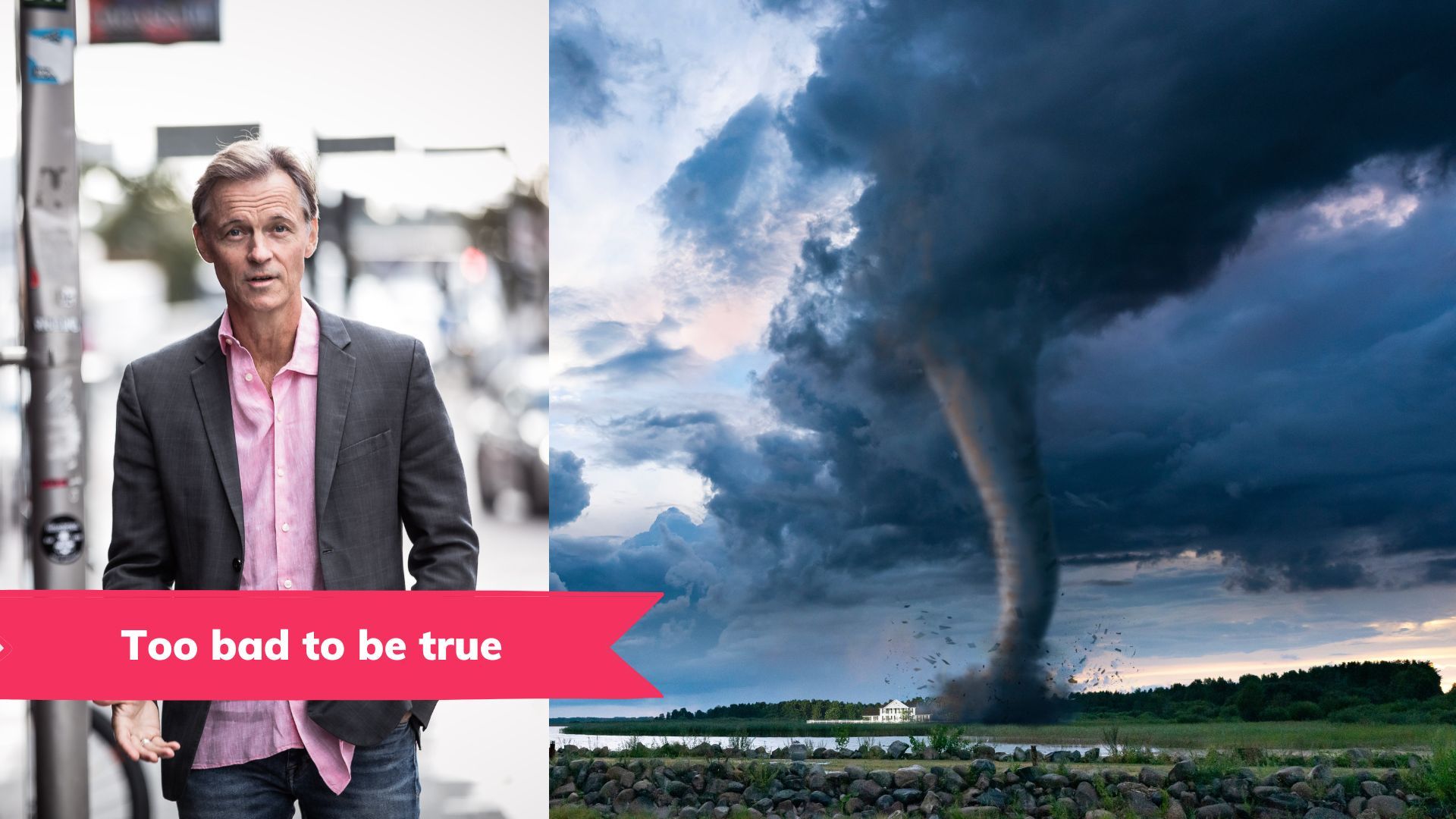
🌪️ The unknown truth about the non-extreme extreme weather
The summer news drought always means a high season for weather news. We will hear that the weather has become increasingly more extreme. Few will ask the follow-up question: is it true? It's a shame, because the answer is essentially no.
Share this story!
This is the first article in a series of investigations into things that are too bad to be true.
Subscribe to our free newsletter and get our fact-based optimistic news, and make sure you don't miss anything too bad to be true.

For those who for one reason or another want to keep a threat of doom alive, it is easy to default to talking about the climate:
- Global warming and its consequences have such long lead times that only the most knowledgeable can remember how the matter was described in the beginning and are therefore able to objectively assess how it develops. It also means that the climate threat can be brought back up as soon as other, more acute, problems subside. If you take another disaster story, the pandemic, as a comparison, the conditions changed within a year or two, so most people who gave it some thought could remember what politicians and experts had said would happen and compare accordingly. But here we are talking about decades and centuries.
- Most people are reasonably interested in the weather for practical reasons, but memory tends to be lacking and you have a thousand other things to think about. Since almost no one is nerdy enough to keep track of temperature, wind, and precipitation, few headlines question "increasingly bad weather".
- There is always dramatic weather going on somewhere on earth.
The latter is probably the simplest thing of all to refer to. It is no coincidence that the climate policy placards are filled with extreme weather events. The first two points also contribute to the fact that it is incredibly easy for those who want to use a storm, a drought, or a flood as a warning example.
But are these not precisely the things that are most frightening in this whole matter? Well, more flooded villages and more blown-off roofs certainly engage more than earlier sprouting and shorter snow season. The problem is that the latter is supported while the former is not.
IPCC: Most extreme weather has not increased
The scientific part of the UN's climate panel, IPCC, confirms in last year's report that the vast majority of the extreme weather types that usually get headlines have not increased. For two of a total of thirteen types, an increase is seen and for two more, there are some signs of an increase.
Another trusted source is the Belgian research institute Cred, which houses the world's most ambitious database of reported natural disasters, EM-DAT. Historically, one can see that the number of cases increases after the Second World War in step with better communications, but about 20 years ago something interesting happens: the weather-related disasters level off.
IPCC on various extreme weather categories
Let's look closely at what the IPCC says about different categories.
Heat waves: yes, an increase is noticeable.
That the number of hot days has increased and the number of cold nights is fewer is logical, given that the average temperature has risen a degree since the middle of the 19th century. Heat waves have generally become more common (although not everywhere).
This is often presented as a dangerous trend, as more people die from heat stroke. There are those who think that it is unethical to point out what I am about to, but given the media's bias towards heat mortality, I think it needs to be said: significantly more people die from cold than from heat. It's not about a few tens of percent, it's about many times more - between seven and fifteen times, depending on which of the many studies confirms the subject being observed.
An interesting detail in this context is that many absolute heat records have been in place for decades, in some cases over a hundred years. The latter applies, for example, to some US states. The Swedish record of 38.0 degrees has been registered twice, in 1933 and 1947, so it turns 75 years old this year. We have not been near it since. All Nordic records except the Finnish one are more than 47 years old.
It should be noted that several countries further south in Europe have broken their heat records in recent years. Still, the many sustainable records show how difficult the atmosphere's behavior is to predict.
Every now and then, the temperatures get really spectacular, like during the astonishing heat wave in western Canada last summer.
Extreme precipitation: yes, an increase is noticeable.
Surprisingly, this has no direct connection to floods, which have not increased (see below). This is because, for places that are normally dry, even 20-30 millimeters of rain in a day (which hardly results in flooding) corresponds to an extreme precipitation event.
Wildfire weather: the probability of an increase is 50-50.
This is a bit of a tricky category. The actual number of forest fires is not measured, as a number of factors in addition to the weather play a role in causing them to occur and spread. But there is a medium probability that the type of weather that favors wildfires has become more common.
Lack of soil moisture (so-called agricultural drought and ecological drought, respectively): the probability of an increase is 50-50.
Tropical cyclones: no noticeable trend.
Other storms: no noticeable trend.
Floods: no noticeable trend.
Meteorological and hydrological drought (what is usually meant by drought): no noticeable trend.
Thunderstorms: no noticeable trend.
Lightning strikes: no noticeable trend.
Hail: no noticeable trend.
Extreme winds: no noticeable trend.
Tornados: no noticeable trend.
Facts are not always popular
One of the few researchers who actively conveys the collective knowledge about extreme weather events is Professor Roger Pielke at the University of Colorado. He has had to receive many hard blows because he explains what the charts actually say.
Because reporting these facts is not popular. I have had several conversations, partly confidential, with Debby Guha-Sapir, the head of the institute responsible for EM-DAT, and there is no doubt that there is external pressure to keep the numbers under wraps.
Sometimes the statistics have been interpreted creatively. Reputable The Lancet claimed a few years ago, using data from EM-DAT as a basis, that the number of extreme weather events had increased by 46 percent in 13 years. There is, as mentioned, no statistically significant increase (only the one that can be explained by better reporting up until 20 years ago), but the trick was to choose two points on the curve that seemed to give that result. The increase is so bizarrely large that this in itself should have caused red flags, but the information was reproduced without hesitation in major Swedish newspapers and also by the then Swedish Minister of Climate.
The UN agency WMO also sometimes reproduces the information they obtain from EM-DAT in a fraudulent manner, and one must be well acquainted with what the statistics look like to understand that the agency has really looked for confirmation that the disasters have increased and worsened.
Investigate also what is too bad to be true
It is hard to imagine a politician or activist claiming that we see the worst violence, the biggest economic gaps, or the worst mental illness ever without at least some journalists questioning the claim. In the case of the climate, such reviews are hardly ever made.
The Greta Thunberg-inspired movement Fridays for Future has even had a moment of silence for the "victims of the climate crisis". I’m guessing the victims in question are not the people throughout history who have consistently lost their lives in certain extreme weather events, but the imaginary weather victims who have been added due to our carbon dioxide emissions. Sorry if it sounds harsh, but this figure of thought is absurd because the number of deaths in weather-related natural disasters has completely plummeted in the last hundred years. In relation to the population, this is a 99% reduction.
We can't lean back
Does the above knowledge mean that everyone can fall back asleep and stop thinking about global warming? No. Why would they? It means that it will be a little easier to tackle the problem with the right proportions and the right methods. Only misanthropic politicians and debaters assume that people cannot keep several thoughts in their heads at the same time.
There is a simple method to feel safe when discussing this issue, as well as any issues of large-scale change, but it is lousy at creating slogans: never use anecdotal evidence but always only trends and averages. Never. Always.
Anders Bolling
By becoming a premium supporter, you help in the creation and sharing of fact-based optimistic news all over the world.



